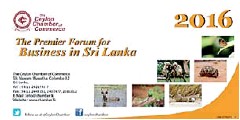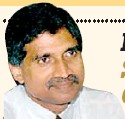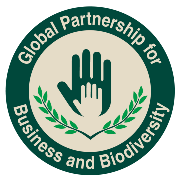
Ceylon Chamber issues desk calendar with a focus on biodiversity
Ceylon Chamber issues desk calendar with a focus on biodiversity
The Ceylon Chamber of Commerce, the country’s premier business chamber, has issued a calendar for the year 2016, with a focus on Sri Lanka’s valuable biodiversity
The calendar consists of attractive pictures of Sri Lankan fauna such as the sambar and the Sri Lankan leopard, the latter being classified as an endangered species according to the International Union for Conservation of Nature (IUCN) Red List of Threatened Species.
It also includes pictures of the little green bee-eater and the Indian star tortoise. An image of an old world species of monkey endemic to Sri Lanka and a picture of a butterfly, which can be found in abundance in the wet and intermediate zones of the island, also light up the calendar.
Developed in collaboration with Biodiversity Sri Lanka (previously the Sri Lanka Business and Biodiversity Platform), the calendar includes Public and Bank Holidays, Holidays coming under the Shop and Office Act, Charter Party Holidays and Chamber Holidays.
It also includes important contact details of the Business Service Units of the Ceylon Chamber of Commerce, for the convenience of the business community.
Biodiversity Sri Lanka is a collaborative initiative of the Ceylon Chamber of Commerce, IUCN and Dilmah Conservation, and is a tool to foster dialogue between the private sector and conservation agencies.

WNPS lecture: ‘Colombo wetlands under threat’
WNPS lecture: ‘Colombo wetlands under threat’
Prof. Weerakoon is currently attached to the International Union for Conservation of Nature (IUCN).
The wetlands of Colombo are extremely important for the flood management of the commercial capital. They also support a rich variety of species, including many endemic and threatened species, despite it being a highly urbanised area. For this reason, several wetlands have been designated as protected areas. The Colombo wetlands also provide a suite of other ecosystem services such as recreation, provision of food, microclimate regulation, and educational opportunities, among others. They, however, are perhaps the most threatened wetlands in the country!
The Beddagana Biodiversity Park and the Thalawathugoda Wetland Park were established with the aim of promoting awareness and recreational opportunities for both local and foreigners alike. Many of the users of these recreational facilities, however, are oblivious of the richbiodiversity that exist in the Colombo wetlands. The aim of this presentation is to provide an overview of the biodiversity and ecosystem services provided by Colombo wetlands, the major threats to these wetlands and what can be done to improve the present status of them.

Latest Edition of the CBD Secretariat’s Business.2020 Magazine—Focus on ABS
It has been a year since the coming into force of the Nagoya Protocol on Access to Genetic Resources and the Fair and Equitable Sharing of Benefits Arising from their Utilization at the twelfth Conference of Parties (COP 12) to the Convention on Biological Diversity held in Pyeongchang, Republic of Korea. We therefore felt that it was appropriate to shine a spotlight on this issue for the business community and discuss the various opportunities and challenges that face us in implementing this important Protocol. The articles in this edition of business 2020 will help companies and other readers to better understand the provisions, opportunities and obligations inherent in the Nagoya Protocol. You will find the articles interesting and informative.

Understanding inclusive and holistic DEVELOPMENT
Understanding inclusive and holistic DEVELOPMENT
The undeniable role of local authorities and the civil society organisations in policy formation and development
Sadly the Centre hangs on to power and the money is also kept within the Central Government and its affiliated bodies. The LAS which provided a yeoman service to the public has really lost its pride of place. Unblocking the resources which can flow to the LAS can lead to unlocking the huge capacity and potential the LAS have to serve the public.
I had the great opportunity to represent Sri Lanka at the recently held Policy Forum on Development, Meeting of the Asia and Pacific Region, in Bangkok, Thailand. This initiative was launched in March 2010 involving 700 CSOS and LAS to reflect and define ways to improve the effectiveness of all actors involved in the EU Development Cooperation. The PFD held its inaugural meeting in November 2013 after the joint declaration which acknowledged that CSOS and LAS as essential components of any working democracy and the need for a permanent space for policy dialogue.
The opportunity I received was all thanks to Ms. Salima Chitalia of the European Union, Ms. Dr. Bernadia Tjandradewi, Secretary General of the UCLG-ASPAC and Ms. Hemanthi Goonesekera of the Federation of Sri Lanka’s Local Government Association.
The experience for me was invaluable and I feel that Sri Lanka still has a chance to steer on to the path of sustainable development IF we take the corrective measures right now.
MDGS
At the turn of the new millennium the world had ambitious plans to reach the eight Millennium Development Goals. Many initiatives were launched to keep these promises. However, by 2011, all actors realised that achieving these MDGS fully by 2015 was not possible due to various factors. One reason was the rapid changes in socio-economic and political contexts in all parts of the world. The other being that the LAS and CSOS played an insignificant role in the development processes including policy formation. All international aid agencies had been discussing with central governments and hoped that the dialogue would flow to the next levels and action would be taken. Unfortunately the flow of information, plans and activities did not take place at the ground level as envisaged. In many countries in Asia, including Sri Lanka, all these factors made the MDGS unachievable.
SUSTAINABLE DEVELOPMENT GOALS (SDGS)
The UN has come up with 17 SDGS to ensure that in the next 15 years we not only achieve the development goals but also ensure that such achievements are sustained for the benefit of the future generations.
The 17 MDGS are 1) End poverty in all its forms everywhere; 2) End hunger, achieve food security and improved nutrition and promote sustainable agriculture; 3) Ensure healthy lives and promote well-being for all at all ages; 4) Ensure inclusive and equitable quality education and promote lifelong learning opportunities for all; 5) Achieve gender equality and empower all women and girls; 6) Ensure availability and sustainable management of water and sanitation for all; 7) Ensure access to affordable, reliable, sustainable and modern energy for all; 8) Promote sustained, inclusive and sustainable economic growth, full and productive employment and decent work for all; 9) Build resilient infrastructure, promote inclusive and sustainable industrialisation and foster innovation; 10) Reduce inequality within and among countries; 11) Make cities and human settlements inclusive, safe, resilient and sustainable; 12) Ensure sustainable consumption and production patterns;13) Take urgent action to combat climate change and its impacts; 14) Conserve and sustainably use the oceans, seas and marine resources for sustainable development; 15) Protect, restore and promote sustainable use of terrestrial ecosystems, sustainably manage forests, combat desertification, and halt and reverse land degradation and halt biodiversity loss; 16) Promote peaceful and inclusive societies for sustainable development, provide access to justice for all and build effective, accountable and
inclusive institutions at all levels; 17) Strengthen the means of implementation and revitalize the global partnership for sustainable development.
TAKING THE SDGS FORWARD
Sri Lanka has still not understood the importance of inclusive and holistic development. During the deliberations at the PDF, it was revealed that this is the bane of all Asian countries. The mistakes which many of these governments made by not co-opting the Local Authorities, must be overcome in order to seriously work towards achieving the SDGS.
There is also responsibility on the part of the Governments as well as the international development aid agencies to have a plan to include both CSOS and LAS in this journey. To this I am very pleased that the EU has taken firm steps to encompass all countries.
I feel that Sri Lanka has to improve its mode of operation in order to reap the maximum of international development support.
At present there are only two departments that coordinate between the Central Government and the aid agencies; one at the Ministry of Foreign Affairs and the other the External Resources Department of the Ministry of Finance. I see a HUGE draw back as far as these two departments are concerned; we need to understand that several other key ministry departments need to be co-opted for the optimal utilization of billions of Euros and Dollars coming into the country.
This is a necessity in today’s context where unlike in the 70s and 80s there are many aid agencies. Very recently the government of China also launched its own international development bank. The support is out there. So unless Sri Lanka changes its mode of operation, achieving the SDGS will not be a reality.
CSOS PERSPECTIVE
Speaking at the inaugural PDF in Bangkok, a CSO representative from India presented the state of affairs in development in her country. She said that there was absolutely no transparency when it came to development projects and how the aid was being utilised.
There is abuse of power in the disbursement of funds and Local Authority representatives are involved in the awarding of contracts.
She added that not only the LAS kept the rate payers in the dark; they did not even consider involving them to plan development activities, although some discussions took place. The situation is identical in Sri Lanka as well. The Central Government hardly allocates resources to the LAS. The provincial system too takes a similar approach. The LAS are starved of resources. Sadly the elected representatives are more interested in individual and collective ‘power’ and not providing a service to the rate payers.
UNBLOCKING AND UNLOCKING THE LAS
In Sri Lanka the LAS have been ignored since the 13th Amendment. Prior to that the Centre and the LAS were the two and most effective bodies that served the public.
However, since 1987 this has been lost due to the Provincial Council system being introduced.
Sadly the Centre hangs on to power and the money is also kept within the Central Government and its affiliated bodies. The LAS which provided a yeoman service to the public has really lost its pride of place. Unblocking the resources which can flow to the LAS can lead to unlocking the huge capacity and potential the LAS have to serve the public.
FROM LAS TO PARLIAMENT
One of the reasons why the LAS are being ignored to such an extent is that in the past those who were elected into LAS eventually went to Parliament as members. They had many years of serving the public before they became members of Parliament.
For example former Prime Ministers D. M Jayaratne and Ratnasiri Wickramanayake were members of the LAS long before they became MPS. When a person has served at the Local Authority level, they understand the needs and the service an LA can effectively render. Unfortunately in the present day general elections, about 60 percent of the representatives are parachuted from various corners of the country with zero experience on governance and public service.





